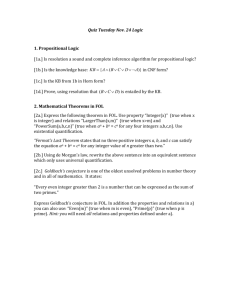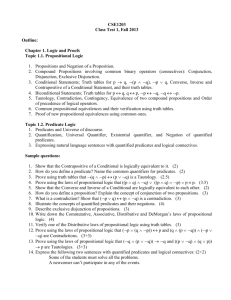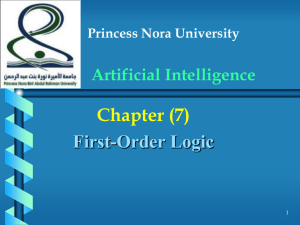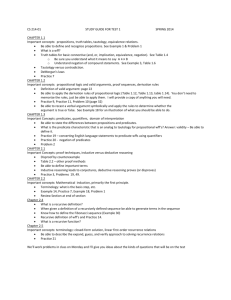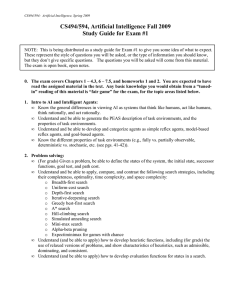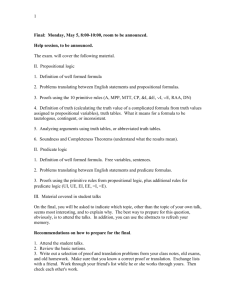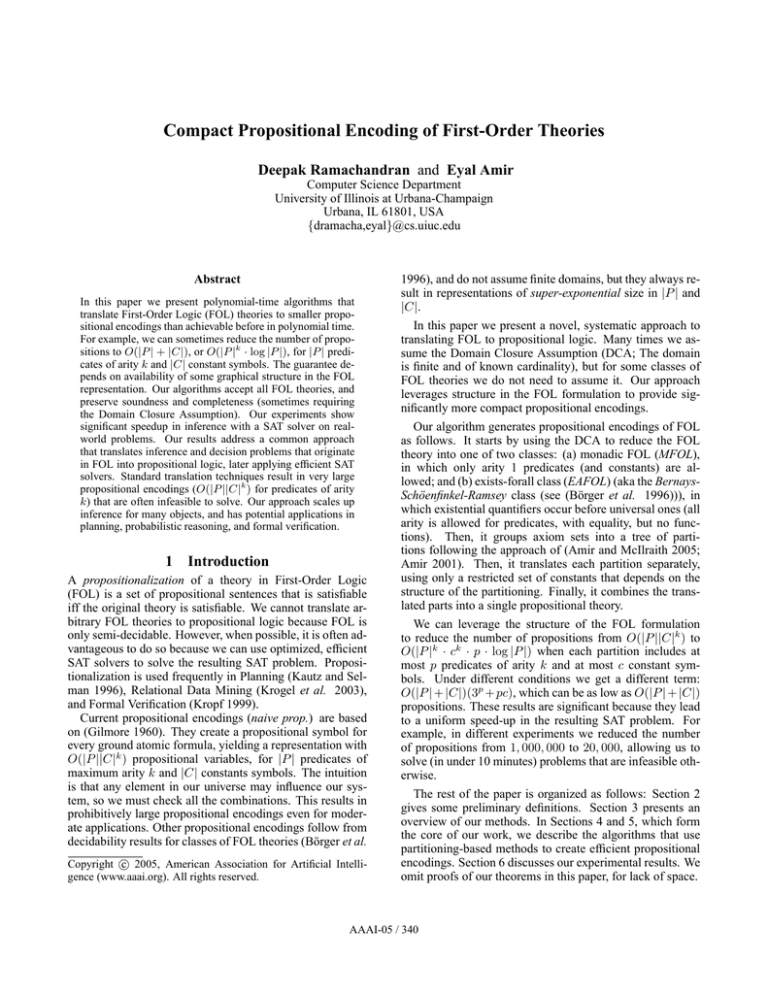
Compact Propositional Encoding of First-Order Theories
Deepak Ramachandran and Eyal Amir
Computer Science Department
University of Illinois at Urbana-Champaign
Urbana, IL 61801, USA
{dramacha,eyal}@cs.uiuc.edu
Abstract
In this paper we present polynomial-time algorithms that
translate First-Order Logic (FOL) theories to smaller propositional encodings than achievable before in polynomial time.
For example, we can sometimes reduce the number of propositions to O(|P | + |C|), or O(|P |k · log |P |), for |P | predicates of arity k and |C| constant symbols. The guarantee depends on availability of some graphical structure in the FOL
representation. Our algorithms accept all FOL theories, and
preserve soundness and completeness (sometimes requiring
the Domain Closure Assumption). Our experiments show
significant speedup in inference with a SAT solver on realworld problems. Our results address a common approach
that translates inference and decision problems that originate
in FOL into propositional logic, later applying efficient SAT
solvers. Standard translation techniques result in very large
propositional encodings (O(|P ||C|k ) for predicates of arity
k) that are often infeasible to solve. Our approach scales up
inference for many objects, and has potential applications in
planning, probabilistic reasoning, and formal verification.
1
Introduction
A propositionalization of a theory in First-Order Logic
(FOL) is a set of propositional sentences that is satisfiable
iff the original theory is satisfiable. We cannot translate arbitrary FOL theories to propositional logic because FOL is
only semi-decidable. However, when possible, it is often advantageous to do so because we can use optimized, efficient
SAT solvers to solve the resulting SAT problem. Propositionalization is used frequently in Planning (Kautz and Selman 1996), Relational Data Mining (Krogel et al. 2003),
and Formal Verification (Kropf 1999).
Current propositional encodings (naive prop.) are based
on (Gilmore 1960). They create a propositional symbol for
every ground atomic formula, yielding a representation with
O(|P ||C|k ) propositional variables, for |P | predicates of
maximum arity k and |C| constants symbols. The intuition
is that any element in our universe may influence our system, so we must check all the combinations. This results in
prohibitively large propositional encodings even for moderate applications. Other propositional encodings follow from
decidability results for classes of FOL theories (Börger et al.
c 2005, American Association for Artificial IntelliCopyright gence (www.aaai.org). All rights reserved.
1996), and do not assume finite domains, but they always result in representations of super-exponential size in |P | and
|C|.
In this paper we present a novel, systematic approach to
translating FOL to propositional logic. Many times we assume the Domain Closure Assumption (DCA; The domain
is finite and of known cardinality), but for some classes of
FOL theories we do not need to assume it. Our approach
leverages structure in the FOL formulation to provide significantly more compact propositional encodings.
Our algorithm generates propositional encodings of FOL
as follows. It starts by using the DCA to reduce the FOL
theory into one of two classes: (a) monadic FOL (MFOL),
in which only arity 1 predicates (and constants) are allowed; and (b) exists-forall class (EAFOL) (aka the BernaysSchöenfinkel-Ramsey class (see (Börger et al. 1996))), in
which existential quantifiers occur before universal ones (all
arity is allowed for predicates, with equality, but no functions). Then, it groups axiom sets into a tree of partitions following the approach of (Amir and McIlraith 2005;
Amir 2001). Then, it translates each partition separately,
using only a restricted set of constants that depends on the
structure of the partitioning. Finally, it combines the translated parts into a single propositional theory.
We can leverage the structure of the FOL formulation
to reduce the number of propositions from O(|P ||C|k ) to
O(|P |k · ck · p · log |P |) when each partition includes at
most p predicates of arity k and at most c constant symbols. Under different conditions we get a different term:
O(|P | + |C|)(3p + pc), which can be as low as O(|P | + |C|)
propositions. These results are significant because they lead
to a uniform speed-up in the resulting SAT problem. For
example, in different experiments we reduced the number
of propositions from 1, 000, 000 to 20, 000, allowing us to
solve (in under 10 minutes) problems that are infeasible otherwise.
The rest of the paper is organized as follows: Section 2
gives some preliminary definitions. Section 3 presents an
overview of our methods. In Sections 4 and 5, which form
the core of our work, we describe the algorithms that use
partitioning-based methods to create efficient propositional
encodings. Section 6 discusses our experimental results. We
omit proofs of our theorems in this paper, for lack of space.
AAAI-05 / 340
2
Preliminaries
We assume familiarity with the standard definitions of First
Order Logic. Also, recall that formula F is in Prenex form if
all of its quantifiers appear before all of its literals, in which
case M atrix(F ) denotes F without its quantifiers.
A logical theory is a set of formulae. For logical theory
τ , L(τ ) is its signature and L(τ ) is its language. Lpred (τ )
and Lconst (τ ) are the set of predicate symbols and constant
symbols respectively of τ . In the rest of the paper we restrict
our attention to languages with no function symbols.
A formula in prenex form τ = Q.M , is in the monadic
class if the arity of all its predicates is exactly one. It is
in the EAFOL class if Q ∈ ∃∗ ∀∗ (this is usually called the
Bernays-Schöenfinkel-Ramsey class in Mathematical Logic
and is known to be decidable (Börger et al. 1996)).
We use the convention that P, Q, R represent predicates,
a, b, c constants in a logical theory and x, y, z are variables.
simple example, whereas the brute-force encoding had 16
propositional variables, the new encoding has 12.
p1
h2
p2
h3
p3
h4
p4
h+
1
p1
h+
2
p2
Motivating Example
p4
h+
3
p3
h1
3 Overview
3.1
h1
h2
h3
h4
Figure 1: A naive pigeonhole encoding and its reformulation
In this section we will describe the intuition behind our work
with the help of a toy example.
Consider the well-known Pigeon-principle problem. It is
typical to solve it by brute force: for example by creating a
boolean formula with O(n2 ) variables and checking for its
satisfiability. In fact, looking at Figure 1(a), it does not seem
that there is any kind of structure to exploit.
We will show however, that there is a simple reformulation of this problem in FOL which leads to a readily decomposable theory. Consider Figure 1(b). We have partitioned
+
the theory into a tree and introduced the predicates h+
1 , h2
+
+
and h3 where for example h2 (p) means that pigeon p is not
placed in any hole i s.t. hi appears in the subtree rooted at
h+
2 (i.e. p is not in h1 or h2 ). Then for example we have the
following axiom (which appears in the root partition):
+
+
∀p[h+
1 (p) ⇔ (h2 (p)∧h3 (p))]
And to exclude each pigeon from being in more than one
hole we have axioms like the following:
+
∀p[h+
2 (p)∨h3 (p)]
Similar axioms are placed in each interior node of the
tree.To ensure that no two pigeons share a hole, in each leaf
partition we assert:
3.2
Our Algorithm
This section presents a high-level view of the main contribution of this paper. Figure 2 presents the top-level of our algorithm, Compact-Prop. It takes a theory, partitions it into a
tree of of sub-theories, encodes each of the parts in propositional logic separately, and returns the union of the resulting
propositional theories.
Definition 1 (Tree Decomposition). A tree decomposition
is a tree of partitions {Ai }i≤n such that if a symbol appears
in Ai , Aj then it appears on the tree path between them.
Theorem 1 (Correctness and Complexity). Let A be a
FOL theory. Procedure Compact-Prop(A,True) (Figure 2)
returns propositional theory P rop that is satisfiable if and
only if A has a model. Compact-Prop(A,False) returns
propositional theory P rop that is satisfiable if A has a
model. Either option takes time O(|P rop|) plus the time
for the chosen implementation of treeDecomp(A).
Theorem 2 (Output Size). Let A be a FOL theory with
|P | predicates and |C| constants. If hT, {Ai }i≤m i is a tree
decomposition of A with degree d and at most p predicates
Procedure Compact-Prop(FOL theory A, boolean M )
∀p∀q[hi (p)∧hi (q) ⇔ (p = q)]
Finally, in the root partition we put the following constraint to check if there is a satisfying assignment:
∀p[¬h+
1 (p)]
The structure that emerges from this transformation can
be used to create a propositional encoding that is more compact by a factor of logn n . We will show in this paper that it
is only necessary to create a propositional variable for every predicate and every constant that appears in the subtree
of the partition in which the predicate appears. So, in this
1. Let A′ ← Reduce-FOL(P renex(A), Const(A), M ).
2. Partition A′ into a tree T of partitions: Let hT, {Ai }i≤m i be
the returned value from treeDecomp(A′ ).
3. For every i ≤ m,Sset P ropi ← Part-Prop(Ai , T, M )
4. Return P rop = i≤m P ropi
Procedure Part-Prop(FOL partition Ai , Tree T , boolean M )
1. If M , then return Part-Prop-MFOL(Ai ) (see Section 5.1).
2. Otherwise, return Part-Prop-EAFOL(Ai , T ) (see Section
5.2).
Figure 2: Our translation procedure to propositional logic.
AAAI-05 / 341
and c constants in every partition, then Compact-Prop(A,
M ) returns
1. O((|P | + |C|) · (3p + pc)), if M = T RU E.
2. O(|P |k ·ck ·p·logd |P |), otherwise, for arity-k predicates.
The intuition behind Compact-Prop is that under some
conditions one may limit predicate instantiations to only
some constants. Such conditions hold for theories in MFOL
and EAFOL that are partitioned in a tree decomposition. In
addition, when we are given an arbitrary FOL theory, we
make the DCA (if possible), convert the theory to EAFOL
or MFOL, and apply the propositional conversion to this new
theory. Sections 4.1 and 4.2 describe these cases in detail.
Section 5.3 describes the partitioning process and the general conversion of FOL to EAFOL and MFOL (assuming
DCA).
A sketch for the proof of the number of propositions (Theorem 2) is as follows. If the tree has degree d and we have
an EAFOL theory, then level h in the tree has dh nodes (the
root is at level 0). At every node of level h we have dH−h c
constant symbols (there are c constants in each leaf of the
tree) that may be combined with every predicate (of arity k)
at that node. Thus, the total number of propositions for level
h is dh · p · d(H−h)·k · ck = dH · d(H−h)·(k−1) · ck · p ≤
|P | · p · d(H−h)·(k−1) · ck .
Thus, the total number of propositions overall is
Plog m
O( h=0d ·|P | · p · d(H−h)·(k−1) · ck ) which is bounded
from above by to O(logd m · p · |P |k · ck ) for k ≥ 1. That
bound becomes O(|P |k · ck · p logd |P |) because m ≤ |P |.
The proof for MFOL is similar.
4
Propositionalizing Partitions
The naive prop. of an FOL theory is created by replacing ground atoms with the corresponding subscripted
proposition(e.g P (A) with PA ), universally quantified
formulae with the conjunction of their instantiations
(∀x(P (x)∨Q(x)) with (PA ∨QA )∧(PB ∨QB ) . . .) and existentially quantified formulae with the disjunction of their
instantiations (e.g ∃xP (x, C) with PhA,Ci ∨PhB,Ci . . .).
This approach requires the Domain Closure Assumption
(DCA; every element in the universe is referenced by some
constant symbol) and (if the theory has equality) the Unique
Names Assumption (UNA; each constant symbol refers to a
unique element). It is neither sound nor complete without
them. The intuition is that there may be a model M with
some element in its universe A such that P M (A) is true and
thus M |= ∃xP (x), but there need not exist some constant
a in the theory such that P (a) is true, unless the DCA holds.
Here we present principled approaches to prop. for
MFOL and EAFOL without making the DCA or the UNA.
These techniques will be used in the construction of the efficient partitioned propositional encodings of section 5.
4.1
Definition 2. A monadic FOL formula τ in prenex form is in
proposition-ready (PR) form if M atrix(τ ) is a conjunction
of disjunctions of factors.
Theorem 3. Every monadic FOL formula can be represented in a logically equivalent proposition-ready form.
Example 1. Let F = ∀y∃x(P (x)∧Q(y)). Then, the stepby-step conversion of F into PR form is shown below:
∀x∃y(P (x)∧Q(y))
⇔
⇔
⇔
⇔
∃y∀x(P (x)∧Q(y))
∃y(∀xP (x)∧Q(y))
∃y(¬∃x¬P (x)∧Q(y))
¬∃x¬P (x)∧∃yQ(y)
Note that in the first step, we have used the fact that the
relative order of existential and universal quantifiers is irrelevant when all the predicates are monadic (Börger et al.
1996).2
We now define the alphabet of our propositional encoding.
If L is the language of a monadic first order formula τ then,
P rop(L) , {Pc | P ∈ Lpred (L), c ∈ Lconst (L)} ∪
{Eh[¬]P1 ,[¬]P2 ,...[¬]Pn i | P1 . . . Pn ∈ Lpred (L)}
Given a formula τ in PR form, each factor appearing in it
can be replaced by the corresponding propositional symbol
in the above alphabet. The result of these substitutions is a
propositional formula we call P(τ ).
Definition 3. P : L(L) → L(P rop(L)) is defined as follows: If τ is in PR form,
1. If τ = P (a) then P(τ ) , Pa
2. If τ = ∃x([¬]P1 (x)∧ . . . ∧[¬]Pn (x)) then P(τ ) ,
Eh[¬]P1 ,...,[¬]Pn i
3. If τ = ¬τ ′ then P(τ ) , ¬P(τ ′ )
4. If τ = τ1 ∧ . . . ∧τn , then P(τ ) , P(τ1 )∧ . . . ∧P(τn )
5. If τ = τ1 ∨ . . . ∨τn , then P(τ ) , P(τ1 ) ∨ . . . ∨P(τn )
Otherwise P rop(τ ) is undefined.
Now we define a set of axioms E(P, C) that relates propositions of the form EhP1 ...i with each other and those of the
form Pa . Let P = {P1 , P2 , . . . Pn } be a set of monadic FOL
predicates and C be a set of constants. Then
E(P, C) ,
^
([¬]Pi1 c ∧ . . . [¬]Pik c ⇒ Eh[¬]Pi1 ,...[¬]Pik i )
c∈C,k≤n,
i1 ...ik ∈P
^
∧
(1)
Eh[¬]Pi1 ...[¬]Pik i ⇒ Eh[¬]Pi1 ...[¬]Pil i ∧Eh[¬]Pil+1 ...[¬]Pik i
k≤n,l≤k
i1 ...ik ∈P
^
∧
Eh[¬]Pi1 ...[¬]Pik−1 i ⇒ Eh[¬]Pi1 ...Pik i ∨Eh[¬]Pi1 ...¬Pik i
i1 ...ik ∈P
Monadic Theories
We define a factor as a monadic FOL formula that is either
an atom or is of the form ∃x(L1 ∧ . . . ∧Ln ) where each Li is
a monadic literal with argument x and each predicate occurs
at most once in some Li .
For example, if Pc (≡ P (c)) is true then the axiom Pc ⇒
EhP i ensures that EhP i (≡ ∃xP (x)) is also true. Similarly, if EhP,Qi (≡ ∃x[P (x)∧Q(x)]) is true then the axiom EhP,Qi ⇒ EhP i ∧EhQi ensures that EhP i and EhQi
AAAI-05 / 342
are true; and if EhP i is true, then by the axiom EhP i ⇒
EhP,Qi ∨EhP,¬Qi , EhP,Qi ∨EhP,¬Qi is true.
We will use E(τ ) to mean E(Lpred (τ ), Lconst (τ )).
Example 2. Let τ = (¬∃x(P (x) ∧ Q(x)) ∨ ∃y(R(y) ∧
¬S(y))) ∧ (∃y(¬S(y)) ∨ ∃y(R(y) ∧ ¬S(y))). The propositionalization of τ is
P(τ ) = (¬Eh¬P,¬Qi ∨ EhR,¬Si ) ∧ (Eh¬Si ∨ EhR,¬Si )
Assuming that Lconst (τ ) = {a}
E(τ ) = Pa ⇒ EhP i
∧
Pa ∧¬Qa ⇒ EhP,¬Qi
∧ EhP,¬Qi ⇒ EhP i ∧Eh¬Qi . . . 2
Theorem 4 (Correctness). If τ is a monadic FOL theory,
τ is satisfiable iff P(τ )∧E(τ ) is satisfiable. The number of
propositional symbols in P(τ ) is at most |P | · |C| + 3|P | .
This method creates an exponential number of propositional variables. Section 5.1 discusses how to reduce this
number by a significant amount to make it usable.
4.2
The EAFOL Class
Let T be an FOL theory of the form ∀x1 . . . ∀xn M where
M is quantifier-free, and let C be a set of constants. Then
we define the operator ⊗ as follows:
^
T ⊗C =
M [c1 /x1 , . . . , cn /xn ]
(2)
c1 ,...cn ∈C
Theorem 5. Let τ = ∃y1 . . . ∃ym ∀x1 . . . ∀xn M . Then
τ is satisfiable
iff τ ′ = M [cy1 /y1 , . . . cym /ym ] ⊗
S
Lconst (τ ) {cyi |1 ≤ i ≤ m} is satisfiable. The number
of atoms in τ ′ is bounded by |P |(|C| + m)k .
Proof(sketch): If m = 0, the theorem follows directly
from the closure of universal sentences under substructures
(Börger et al. 1996): If U is a substructure of B and B is
a model of a universal theory τ , then also U |= τ . Therefore it suffices to check satisfiability for structures with |C|
elements.
Otherwise, since the existential quantifiers occurs before
the universal quantifiers, they can be replaced by skolem
constants to get a universal theory for which the above case
holds. 2
Example 3. Let τ = ∃y∀x[P (a, x)∨Q(b, y)]. Since τ is in
the EA class, we can propositionalize τ as
[P (a, x)∨Q(b, cy )] ⊗ {a, b, cy }
= (P (a, a)∨Q(b, cy ))∧(P (a, b)∨Q(b, cy ))
∧(P (a, cy )∨Q(b, cy ))
where cy is the skolem constant for y and each atom is
treated as a propositional variable. 2
5
Creating Compact Propositional Encoding
In this section we present the subroutines of our propositional encoding algorithm Compact-Prop (Figure 2). Our
method is informed by the principles of Partition-based reasoning (Amir and McIlraith 2005), an efficient reasoning
PART-PROP-MFOL(A)
A is a partition containing only monadic predicates.
1. Return P(A) ∪ E(A) (see Definition 3 and Equation 1).
Figure 3: Compact Propositional encoding for Monadic theories
framework for FOL where theories are decomposed into domains connected in a tree structure and inference is performed by consequence finding within the domains and
message-passing between domains.
It relies on a subroutine treeDecomp that finds tree decompositions (e.g., (Amir 2001; Amir and McIlraith 2005)),
for which we omit the details. Implementations can be found
on the website of the authors. The success of our algorithm
relies on the existence of graphical structure in the problem
instance. However, we do not require that the problem be
completely decomposable into sub-theories. Any degree of
decomposition in the FOL representation can be exploited to
yield a more compact SAT encoding.
The completeness and soundness of Partition-based reasoning crucially depends upon the following theorem from
(Craig 1957):
Theorem 6 (Craig’s Interpolation Theorem). If α and β
are First-order formula s.t. α ⊢ β, then there is a formula
γ ∈ L(L(α) ∩ L(β)) such that α ⊢ γ and γ ⊢ β.
This result ensures that if all messages from one partition
that are relevant to another are sent to it, then the inference
procedure is complete.
5.1
Partitioned Encoding for the Monadic Class
For the MFOL class, the propositionalization algorithm
(PART-PROP-MFOL in Figure 3) needs to propositionalize each predicate with only the constants in the partition
it occurs in. The reason is Craig’s Interpolation Theorem.
Consider a simple situation with two partitions. We can
prove UNSAT iff there is an interpolant (γ) in the intersection of the languages of the partitions such that A1 |= γ and
A2 ∪γ |= F ALSE. If indeed our theory is UNSAT, then we
have such a γ. Then, the propositional-ready form of γ corresponds to a propositional sentence in the MFOL propositionalization of the previous section. Theorem 4 guarantees
that the propositionalization of A1 indeed entails the propositionalization of γ, and that the propositionalization of A2
entails the negation of that γ. Thus, we can conclude that the
union of the propositionalizations will be UNSAT. A similar
argument gives the other direction (SAT).
S
Theorem 7. Let A = i≤n Ai be a partitioned monadic
theory with a tree decomposition G. Then A is satisfiable
iff the output of Algorithm COMPACT-PROP(which calls
PART-PROP-MFOL) is satisfiable.
Depending on the treewidth of the partitioning (a measure
of how well it can be decomposed (Robertson and Seymour
1986)), the size of the propositional encoding is less than
that of Section 4.1 by an exponential factor. This is because:
(a) the number of predicates that occur in any given partition
AAAI-05 / 343
PART-PROP-EAFOL (FOL partition Ai , Tree T )
1. Set Csubtree(i) the set of constants that appear in the subtree of i
in T (with root at 1).
2. return Ai ⊗ Csubtree(i) (see Equation (2)).
Figure 4: Compact propositional encoding of an EAFOL
partition.
Procedure Reduce-FOL(FOL theory A, constants C, boolean M )
1. If M and A in MFOL, return A.
2. If ¬M and A in EAFOL, return A.
3. If A is ∀xψ(x) (some ψ in FOL with only free variable x),
V
then return |C|
i=1 Reduce-FOL(ψ(ci ), C, M ).
4. Else, A is ∃xψ(x) (some ψ in FOL with only
V|C|−1 x
free variable x), so return
⇒
i=1 (P (ci )
x
(Reduce-FOL(ψ(ci ), C, M ) ∨ P (ci+1 ))) ∧ P x (c1 ) ∧
(P x (c|C| ) ⇒ Reduce-FOL(ψ(c|C| ), C, M )). for a new
predicate P x .
Figure 5: Converting a FOL theory to EAFOL.
is a fraction of |P |, and thus the number of propositions of
the form EhP1 ,...,Pk i is exponentially smaller. (b) Each predicate does not have to be propositionalized with every constant in the theory. Assuming that the number of constants in
the theory is much more than the number of predicates (usually the case in a real-world domain), the number of propositions is significantly less than even the naive prop.(theorem
2).
5.2
Partitioned Encoding for the EAFOL Class
Unlike the previous section, with EAFOL we cannot restrict
the propositionalization to within each partition. For example, suppose P (c) and ∀x[P (x) ⇒ Q(a)] are in different partitions. Because we propositionalize these separately,
P (c) ⇒ Q(a) will not be in the propositional theory and
thus Q(a) cannot be deduced.
Unfortunately, this seems to preclude a completeness theorem ( similar to Theorem 7) for EAFOL. We could not find
an encoding (or proof of the current method) that allows
such a theorem, at the time of this submission. Thus, this
method (Figure 4) is only approximate, as far as we know.
Still, our experimental results (see Section 6) for the current partitioned encoding of EAFOL show promise because
all satisfiability tests with the new encodings (see Table 1)
give correct answers (verified by comparing with the naive
encoding).
5.3
General FOL Theories with the DCA
The subroutine Reduce-FOL(Figure 5) is important because
it supplies the necessary conversion that makes our method
applicable to all of FOL (assuming the DCA).
Traditionally,
one
converts
a
formula
Qx1 ...Qxn ϕ(x1 , ..., xn ) to propositional logic using
DCA by removing quantifiers until we get a fully propositionalized formula. One removes quantifiers recursively as
follows:
• W
Replace
∃x1 Qx2 ...Qxn ϕ(x1 , ..., xn )
with
Qx
...Qx
ϕ(c
,
...,
x
).
2
n
1
n
c1 ∈C
• V
Replace
∀x1 Qx2 ...Qxn ϕ(x1 , ..., xn )
with
Qx
...Qx
ϕ(c
,
...,
x
).
2
n
1
n
c1 ∈C
The traditional method needs to remove n quantifiers, and
gets a formula of size O(nn ∗ |ϕ|) with O(|P | · |C|k ) for
predicates of arity k
Our approach differs from the traditional one in two ways.
First, we stop the process when we reach an EAFOL or
MFOL formula (avoiding some of the exponential blowup in
size). Secondly, we break disjunctions into smaller clauses
that are easier to decompose later (each new disjunction has
at most 2 constant symbols, and the order of the constant
symbols is that always ci appears either with ci+1 or ci−1 ).
We get a total number of at most q new predicates (we removed q quantifiers using our replacement above).
6
Experimental Results
Hardware emulators for verifying VLSI circuits are often
designed by using a number of interconnected field programmable gate arrays(FPGA’s). Signals between the chips
must be routed using a limited number of crossbar switches
and pins on each chips. In the Board-Level Routing Problem
(Song et al. 2002), given P chips, each having K groups of
I/O ports, and each group having N ports, we must determine if for a set of routing constraints S = {n1 , . . . , nN },
where nt = (i, j), i 6= j, i, j ∈ {1 . . . P }, there exists an
assignment from S to the I/O ports of the P chips s.t. for
each nt = (i, j), type(i) = type(j).
(Song et al. 2002) solve the BLRP by encoding it directly
into a SAT formula. Using our EAFOL propositionalization algorithm we obtained much more compact encodings.
These translate to a uniform improvement in the running
time of the SAT solvers.
Our algorithm preformed better on all the problem instances reported in (Song et al. 2002). The results are
shown in Figure 1, where both the number of propositional
variables obtained and the running time on the SAT solver
are plotted against the parameters of the problem instance.
On one particular instance(not plotted in the figure), where
(Song et al. 2002) needed 1687 variables and took 1687 sec.
to solve, our algorithm used 695 variables and took 413 sec.
For the second example, we took a machine scheduling problem described in (Ramchandran and Amir 2004).
Briefly, there are items in an assembly line operated upon
by a number of machines in sequence. Each item possesses a state manipulated by the machines. Items must
be scheduled for work on particular machines at particular
time steps so that they go through the correct sequence of
states needed for assembly. The problem is given a set of
constraints(randomly generated in our experiments) on the
items and the machines, to determine whether there exists a
schedule such that all items can be assembled by the deadline. This problem is in the MFOL class.
Table 2 shows the results. The MFOL algorithm outperformed the naive encoding by a large margin. 1
1
It would have been useful to compare the results of our methods with those of (Dixon et al. 2004). Unfortunately we were not
AAAI-05 / 344
Instance
(P,K,M,N)
20-5-2-07
20-5-3-14
20-5-3-11
20-7-3-8
50-5-3-8
50-7-3-8
100-5-3-8
200-5-3-8
#Vars
(naive)
245
275
300
735
855
1687
1720
3585
#Vars
(part.)
224
184
232
420
287
695
633
1014
ZChaff
(naive)
0.68
85.88
100.71
207.79
109.56
1453.00
112.62
91.11
Zchaff
(part.)
1.93
64.82
73.23
113.57
39.92
413.09
34.64
29.37
Satzoo
(naive)
1.8
126.3
142.7
289.8
137.0
1623.9
166.6
128.9
Satzoo
(part.)
1.6
79.4
96.1
147.8
51.2
472.4
49.5
45.7
Berkmin
(naive)
0.10
64.12
83.56
162.33
67.92
1066.02
69.75
84.11
Berkmin
(part.)
0.46
38.4
47.89
77.67
27.1
314.12
22.17
25.99
Relsat
(naive)
0.7
115.3
123.5
266.8
152.3
1771.1
168.4
117.5
Relsat
(part.)
0.5
76.6
81.4
141.8
53.7
489.9
59.3
34.2
Table 1: Board Level Routing Problem
Instance
(#states,#steps)
(150,100)
(250,100)
(350,100)
(150,200)
(250,200)
(350,200)
(150,300)
(250,300)
(350,300)
#Vars
(naive)
45000
90000
135000
75000
150000
225000
105000
210000
315000
#Vars
(part.)
41776
76524
58419
38697
93442
137868
68645
115581
162517
ZChaff
(naive)
15.1
79.4
211.7
74.2
696.8
1562.1
402.5
1997.8
-
Zchaff
(part.)
12.3
65.2
78.4
56.3
244.6
359.6
111.2
344.0
583.2
Satzoo
(naive)
5
129
287
89
722
1487
462
1844
-
Satzoo
(part.)
7
75
91
60
266
348
126
330
537
Berkmin
(naive)
13
87
247
63
744
1612
376
1833
-
Berkmin
(part.)
18
68
85
42
277
381
99
313
560
Relsat
(naive)
24
134
331
122
872
2216
655
-
Relsat
(part.)
18
88
109
78
287
511
194
577
829
Table 2: The Machine Scheduling Problem
7
References
Conclusions and Future Work
In this paper we presented a principled approach to the problem of SAT-reducing an FOL theory. Our algorithms work
in polynomial time, and produce encodings that lead to significant improvement in speed of inference.
The motivation for our work is the evidence that First Order representations hold structure that is lost in the translation to propositional logic. Rediscovering this structure in
the propositional level seems equivalent to checking graph
isomorphism (an NP-hard problem), so it is unlikely that
SAT solvers can rediscover and use this structure at the
propositional level.
We view our work in the context of a body of literature
that recognizes that real world problems are structured. In
particular, our techniques takes advantage of the local structure of theories in order to do efficient reasoning. For a complementary approach that exploits the symmetry of problem
instances rather than their locality see (Dixon et al. 2004).
The success of these methods suggests that the scope of
propositional encoding techniques can be expanded beyond
its current usage. We believe that the first applications could
be in Planning, where there is already an extensive literature
on the use of propositionalization e.g. (Kautz and Selman
1996) and Probabilistic Relational inference (Poole 2003).
Acknowledgements
We would like to thank N.N. Hung for his help with
our experiments.This research was supported by the
DAF Air Force Research Laboratory grant FA8750-04-20222(DARPA REAL program).
able to obtain an implementation of their algorithms at the time of
submission.
E. Amir and S. McIlraith. Partition-based logical reasoning
for first-order and propositional theories. Artificial Intelligence,
162(1-2):49–88, 2005.
E. Amir. Efficient approximation for triangulation of minimum
treewidth. In UAI’01, pages 7–15. Morgan Kaufmann, 2001.
E. Börger, E. Grädel, and Y. Gurevich. The Classical Decision
Problem. Springer-Verlag, 1996.
W. Craig. Linear reasoning. A new form of the Herbrand-Gentzen
theorem. Journal of Symbolic Logic, 22:250–268, 1957.
H. E. Dixon, M. L. Ginsberg, D. K. Hofer, E. M. Luks, and
A. Parkes. Implementing a generalized version of resolution. In
AAAI’04, 2004.
P.C. Gilmore. A proof method for quantification theory: It’s justification and realization. IBM Journal of Research and Development, 4(1):28–35, January 1960.
H. Kautz and B. Selman. Pushing the envelope: Planning, propositional logic, and stochastic search. In AAAI’96, 1996.
M. Krogel, S. Rawles, F. Zelzny, P.A. Flach, N. Lavrac, and
S. Wrobel. Comparative evaluation of approaches to propositionalization. In ILP, pages 197–214, 2003.
T. Kropf, editor. Introduction to Formal Hardware Verification.
Springer, 1999.
D. Poole. First-order probabilistic inference. In IJCAI’03, 2003.
Deepak Ramchandran and Eyal Amir. Compact propositionalization of first order theories. In 5th International Workshop on
Strategies in Automated Deduction, 2004.
N. Robertson and P. D. Seymour. Graph minors. II: algorithmic
aspects of treewidth. Journal of Algorithms, 7:309–322, 1986.
Xiaoyu Song, Willian N. N. Hung, Alan Mischenko, Malgorzata Chrzanowska-Jaeske, Alan Coppola, and Andrew Kennings.
Board level multiterminal net assignment. In Great Lakes Symposium on VLSI. ACM, April 2002.
AAAI-05 / 345

